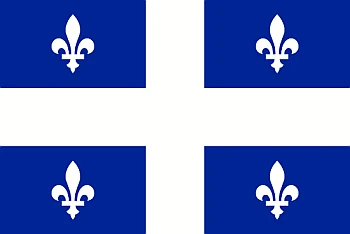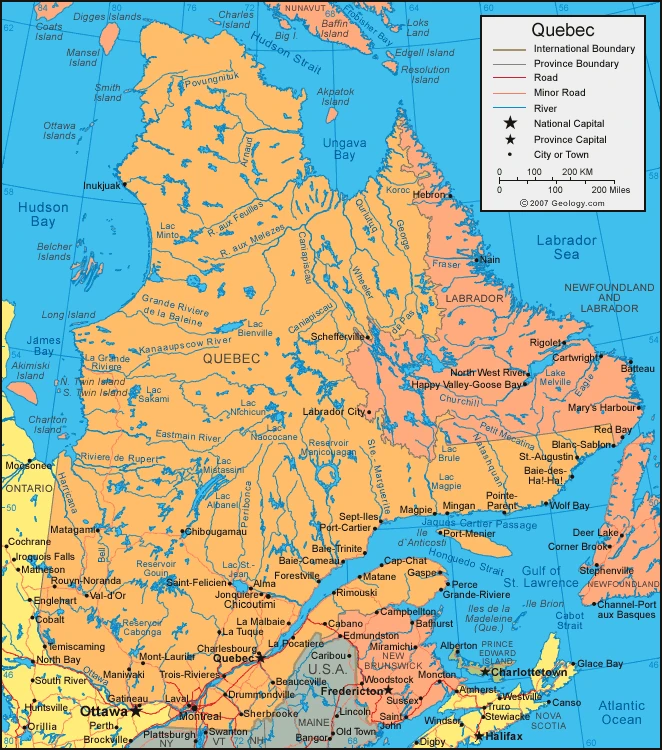
Formation: 1867. The origin of the name: From an Algonquin Indian word meaning “narrow passage” or “strait,” referring to the narrowing of the St. Lawrence River at what is currently Québec City.
8 AM AST = noon GMT; 7 AM EST = noon GMT.
Québec is a province in Canada that is just north of Vermont. It is the largest province in Canada and is known for its food and culture, and is Canada’s only officially French-speaking province. The capital of Québec is Québec City, which is where you’ll find the historic Citadelle and the Musée national des beaux-arts du Québec.
It is shaped like an upside-down triangle, and it borders Canada’s two other provinces, Ontario and New Brunswick, and the United States state of Maine. The most populated city in Québec is Montréal, home to over 15% of Quebec’s population.
Niagara Falls, a popular tourist attraction in Canada and the US, is located on the border between the two countries at the southernmost point of Ontario.
Map of Québec

The climate of Québec
Southern Québec has a temperate continental climate along the St. Lawrence River. However, the bay and Gulf of St. Lawrence have a temperate maritime climate because of the water-to-land ratio. Permafrost reigns in the northern part of the Canadian Shield; only dwarf birches and lichen can grow there.
Montréal’s average temperature for January is 16°f (-8.7°c). Québec City’s average temperature for January is 10°f (-12.1°c). Baie-Comeau’s average temperature for January is 8°f (-13.2°c), and Kuujjuak’s average temperature for January is -10°f (-23.3°c).
In July, the average maximum temperatures in Montréal are 71° Fahrenheit (21.8° Celsius), 66° Fahrenheit (19.1 ° Centigrade) in Québec City, 62° Fahrenheit (16.8° Centigrade) in Baie-Comeau and 53° Fahrenheit (11.4 ° Celsius) in Kuujjuaq. The hottest day on record is 104 °F, measured at Ville Marie on 6th July 1921, and the coldest is -66 °F (-54.4°C), found on Doucet on 5th February 1923.
Facts about Québec
- Quebec is a province in eastern Canada.
- Quebec is the largest Canadian province. It constitutes one-sixth of Canada’s total land area and is second only to Ontario in population.
- Quebec City is the oldest city in Canadian history. It is also called the place where “the river narrows.” Quebec’s name derives from an Algonquin word “where the river narrows.” The city has a fantastic view of the St Lawrence River and Orleans Island.
- Montreal is the largest city in Canada, with an even larger metropolitan area.
- It borders Hudson Strait and Ungava Bay to the north, Newfoundland and Labrador to the east, the Gulf of St. Lawrence, New Brunswick and Maine to the south, New York and Vermont to the west, and Ontario, James Bay, and Hudson Bay on its southwest coast.
- Quebec’s borders have been altered since New France was created in the early 17th century. The French colonial empire extended to the Gulf of Mexico and west of the Mississippi River.
- Today, the leadership of Quebec is still trying to resolve their dispute with Canada over the border between Ontario and Quebec.
- Quebec’s territory comprises three distinct physiographic regions, some of which have unique cultural and natural resources.
- Montreal and Quebec City are densely populated, the most populous region along the St. Lawrence River.
- The lowland plain was initially the location of various aboriginal communities, and then Europeans settled there quickly during the early history of New France. The area remains Quebec’s small but vibrant agricultural sector, but it is also home to growing urban communities and a changing industrial economy.
- Quebec’s Appalachian Uplands is the northern extension of the Appalachian Mountains. It stretches from the Gaspé Peninsula to the border of the United States and covers hills, plateaus, and plains. This region also includes Anticosti Island in the Gulf of Saint Lawrence, northwest of Quebec’s Appalachians.
- The Canadian Shield covers most of the land in Quebec and includes the region north of the St. Lawrence Lowlands. This area is rich in natural resources and provides materials for industry.
- 5.4 miles from Mount D’Iberville is the easternmost region of the Torngat Mountains and is 1,652 meters high. It’s the highest peak in Newfoundland and Labrador.
- The Appalachians are the oldest mountain range in the world. The Appalachians start in the Laurentian hills and run north, ending at Ungava Bay.
- The Canadian Shield covers three divisions: the Laurentians, with thousands of lakes and trees; the taiga region, with stunted trees farther north; and the tundra, where the permafrost prevents the growth of trees.
- Quebec has an ample supply of fresh water. It is estimated that Québec’s waters cover about 71,000 km sq.
- The Saint Lawrence River cuts through southern Quebec from west to east and is one of the most vital waterways in North America. The Ottawa, Saguenay, Saint-Maurice, and Manicouagan rivers are among its most essential tributaries which flow into St. Lawrence.
- Extremes of hot and cold often characterize the weather in Quebec. Quebec is affected by major continental air masses sweeping down from the northwest.
- The country’s northeast regions encounter cold Labrador Current, making summers cool. The humid, hot air from the Gulf of Mexico creates heat waves during summer, resulting in abundant winter snowfall.
- From January’s -11 °F to July’s 52 °F (11 °C), Kuujjuaq seems to have a more extreme range of temperatures. A more extensive range of average monthly temperatures; varies from 14 °F in winter to 68 °F in summer. The temperature can change by 30 °F across 24 hours.
- Montreal gets 140 frost-free days per year, while the north has fewer than 80. The south gets 12-13 weeks of snow, while the north gets 23 weeks of snow.
- The climate in Montreal is less severe, so it is greener with wildlife.
Google Maps of Québec
Getting Around Quebec
All major cities have airports. Bus companies such as Voyageur Lines, Orléans Express, and regional buses cover the whole province. Greyhound buses come from the US, while Limo car serves the Laurentian Mountains and Autobus Viens the Eastern Townships. Rail services are limited to the Southern Quebec region; there is also an extensive highway system for exploring by car.
Visit this page for driving directions in Canada.
